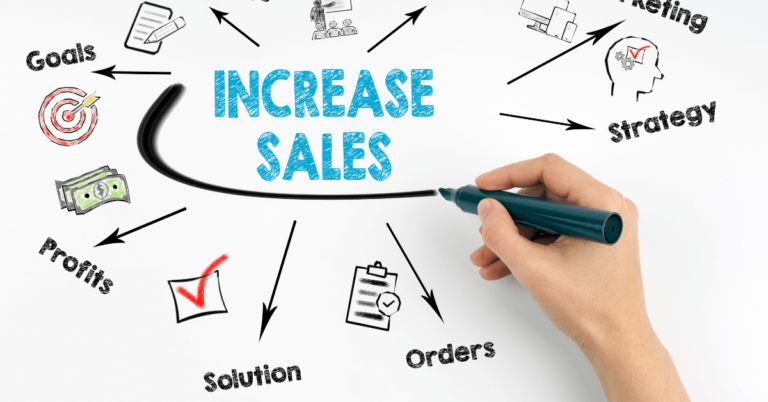A well-defined sales and marketing strategy can make a big difference when it comes to success, as the development of a sales strategy begins with setting your goals, but you need to review your goals over the next year to the next five years, and ensure that all goals are measurable, not only this but other important sales strategies that can increase your sales, invite you to read them in the rest of the article.

Sales Concept
The concept of sales refers to marketing strategies applied to increase sales and revenue by making customers buy what they necessarily need, this depends on the premise that consumers will only buy a product or service if they are effectively persuaded, and as a result, companies that use the concept of sales emphasize strong sales and marketing methods that persuade customers to buy their products.
The importance of increasing your sales
Sales are important when it comes to earning money and developing a business The latter depends on the success of the sales department, although the company has a great empire and great products The enterprise becomes successful when most customers consider buying their products, It is therefore important to balance meeting customers' needs and taking forward the mission of the company And, to keep the business going, you need to find new customers and keep customers that you already have happy and loyal.
When an employer can efficiently increase sales without significantly increasing sales costs business is growing not only in terms of size, but also in terms of margin and profitability and using economies of scale, employers may be able to get discounts on larger inventory numbers, advertising and delivery when expanding This means that the company can double sales but not expenses, making the company more profitable.
Positive sales growth indicates operational efficiency and high customer confidence in the particular company, while a negative growth rate may imply that companies need to improve their operations to remain sustainable.
5 strategies that can increase your sales
The concept of sales comes with strategies that make it effective, as it must be taken into account to increase your sales, as follows:
1. Enter new products or services
Increasing sales depends on providing a wide range of products or services to your customers where you will need to search your market to see if there is a desire for your proposed offer, Consider using some of your existing customers as a test kit, and getting feedback from a test kit can help you manage some risks and figure out how to improve the product or service, Then you will also need to market and promote your new products or services so that people know about them.
You can also use different ways to identify potential customers for your new products, including advertising, marketing, casual calls, social media, referrals, networking, consulting, product/service experiences, internal marketing methods can help your business create a steady stream of potential customers for incoming sales.
2. Expand markets and ensure customer satisfaction
Expanding into new markets can be expensive, but it can increase your customer base, market research will help you understand the potential new market and help you strategize, you will also need to increase sales to think about marketing, sales, distribution and increase your production to meet new demand.
Also make sure your customers feel fully satisfied when using your products or services Making your business more customer-friendly than other companies is vital in growing sales, This is when you offer innovative and unique products better than similar products on the market and do not miss the improvement of customer relations and the treatment of customers available sincerely, Also make sure you value your employees and treat them well so they can pass the same treatment to people coming to your business Improving customer relationships and making sure they are satisfied is valuable for your business and one of the most prominent sales strategies.
3. Highlight the unique point of sale
Make sure your customers are familiar with your product's unique selling points As there is a reason why your product is better than competitors, this is what you should highlight to all customers If your unique point of sale is the price, you are less than competitors You may want to make a loss-inducing sale to draw attention to your low prices, And if your unique point of sale is quality, it may be helpful to distinguish marketing and advertising strategies to highlight this quality to customers.
4. Clarification of product display
Providing options is an important step to increase sales as customers feel in control of the situation But a lot of options can be confusing and can actually hinder the sale, You may have more than three products or services to offer But consider dividing all your choices into three categories, For example, restaurants may have multi-page menus but are divided into starters, main dishes and confectionery categories.
Consider also increasing sales to organize your offerings at "good" and "better" levels, based on price or features, and may be classified by customer types. Entry-level users may have an initial understanding of the product category and will be attracted to basic models. It is worth noting that intermediate users have an average level of product knowledge and prefer a selection of average cost and complexity.
5. Know when to stop
If you have sectors, services or production lines with low margins, low profitability or excessive selling costs, it may be time to get rid of them, right this can be difficult if you have commitments to current offers, but removing less profitable products or services can save you money and allow you to reinvest more wisely, thereby increasing sales.
Conclusion:
Your success in increasing sales is linked to timely seizure of opportunity And it can often happen that such opportunities don't just come to you, It must be created through your efforts, think about how you want to define your brand, And the job you want to be in, for some, this could mean developing and launching a new product. And for others, this may mean coordinating a coherent content marketing strategy and most new companies need to build a core customer base as one of their core objectives.
Other topics:
1. <<7 ways to build customer loyalty >>, businessnewsdaily.
2. << 10 steps to effectively target and communicate with potential customers >>, martech.

Add New Comment